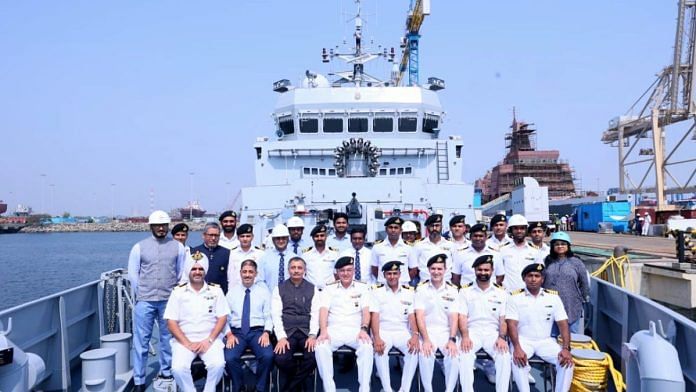At 77 metres in length and displacing over 1,490 tonnes, Arnala is the largest Indian naval vessel to be powered by a diesel engine-waterjet propulsion system, a combination that enhances speed and maneuverability in shallow waters.
“The platform is designed for subsurface surveillance, search and rescue operations and low intensity maritime operations (LIMO); alongside its primary role in anti-submarine warfare. It is further equipped with mine-laying capabilities, a rare feature for its class,” said the Navy in a statement.
Sources in the Navy said, “Since there is a possibility of the adversary’s submarines being required to navigate littoral (coastal) zones with depths as shallow as 50 to 60 metres to achieve effective torpedo firing positions, Arnala is engineered to detect, track and engage such threats at stand-off ranges, mitigating risks to high-value surface assets operating in proximity.”
The vessel will be fitted with an indigenised version of the variable-depth sonar system developed jointly by India’s and Atlas Elektronik, a subsidiary under the German firm Thyssenkrupp. Operating in both active and passive modes, this sonar system is capable of detecting underwater threats at ranges that exceed the engagement envelope of most enemy submarines, providing an opportunity to neutralise hostile platforms preemptively.
The sources also explained the platform’s strategic relevance in the regional maritime context, particularly in relation to Pakistan’s naval posture. “Given Pakistan’s limited inventory of modern surface combatants and the absence of dedicated ASW platforms, its naval strategy in a conflict scenario is expected to rely heavily on submarines. In this environment, the Arnala-class is positioned to play a critical role in securing India’s coastal waters, thereby allowing larger Indian naval assets to operate with greater operational flexibility in offensive or expeditionary roles.”
Named after a coastal fort in Maharashtra, the homegrown vessel has been designed by Garden Reach Shipbuilders & Engineers (GRSE) under a public-private partnership with Larsen & Toubro (L&T). It is also the first Indian naval warship to be both designed and built by the shipbuilder, marking a departure from the traditional practice where the Navy provides the design.
Further, with over 80% indigenous content, the ASW-SWC integrates advanced systems from Indian defence majors such as Bharat Electronics Limited (BEL), L&T, Mahindra Defence and MEIL. The first eight vessels in the ASW-SWC class are being constructed by GRSE, while the remaining eight are to be designed and built by Cochin Shipyard Limited (CSL).
Arnala will replace the Navy’s ageing Abhay-class which are customised variants of the Soviet Pauk-class corvettes, used for coastal anti-submarine operations. The new class marks a significant upgrade over its predecessor, offering a larger size, survivability and advanced combat systems.
A second vessel in the ASW-SWC series is expected to be commissioned later this year. Over time, the Navy plans to deploy all sixteen ASW-SWC vessels to safeguard India’s sixteen major ports, establishing a robust anti-submarine shield along the coastline.
(Edited by Viny Mishra)








